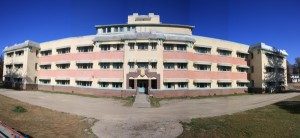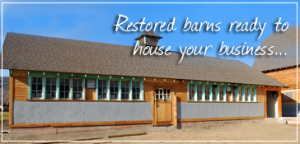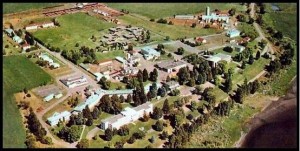Modern Utopian plans that resemble Ebenezer Howard’s original Garden City continue to exist today. Tranquille on the Lake is located just outside of Kamloops and is currently in the planning process of creating an urban farm or “agri-community” as the owner, BC Wilderness Tours prefers to call the concept. The village will be focused on farming as its main economic vehicle and create a community of people who support the ideologies of urban farming and education. The policies of the plan indicate that the village is “a model agri-community development that promotes and provides a precedent for the integration of urban farming and residential development” (Tranquille Limited Partnership 7). Interestingly, this sounds similar to Howard’s town-country as both plans highlight fusing the joys of nature with the collective living of people through the creation of a town in a country setting.
Tranquille was purchased by BC Wilderness Tours in 2000 for 1.5 million dollars. There are thirty-five deserted buildings on the land from previous government-owned incentives. This site has a fascinating history as the buildings were first constructed in 1908 as a tuberculosis sanatorium. The area was then turned into a mental hospital in 1958 and closed in 1984 when institutionalization of mental patients was banned (Young 1). BC Wilderness Tours had many legal battles with the City of Kamloops to obtain the land and finally won in BC Supreme Court.
Interestingly, in the plans for Tranquille on the Lake, there is no mention of the history behind the land perhaps because the owners fear that this would discourage people from buying into the fresh and new “agri-community” concept. The only mention of the historical preservation aspects in the plan mentions that “The TOL Heritage program will include cemetery protection, adaptive restoration of farm infrastructure, buildings, and fields, adaptive restoration of selected buildings, preservation of selected outdoor public spaces” (Tranquille Limited Partnership 7). The lack of detail and attention focused on the history of the land reflects the “tabula rasa” effect of many Utopian plans. BC Wilderness Tours, similar to Howard wants to start completely new in order to build a reformed community from scratch.
Tranquille on the Lake is a privately owned building project and this is similar to the construction of the Garden City, Letchworth. There are also specific building protocols that emphasize Utopian ideologies at play in this “agri-community”. The plan highlights that the agricultural village desires to “connect people to the land” (38). The citizens of Tranquille will also be provided with opportunities to take part in “local food cooking classes, compost donations and harvest celebrations” (38). Lastly, recreational spaces such as a “place of worship should be encouraged to occupy an animate adjacent outdoor space” (38). There are several ideologies immersed into the building plans that exemplify a high level of control of the physical space in order to push certain beliefs about the cultural expectations of the community itself. Originally, Howard used the Garden City as a plan to use physical markers to create a certain kind of social community and this concept is repeated in Tranquille on the Lake. It remains to be seen how successful this “agri-community” will be as BC Wilderness Tours are engaged in policy debates with Kamloops currently. It is hoped that the fascinating historical markers on this land will be salvaged when the construction begins for this Utopian dream, or what could turn out to be a nightmare.
Really amazing source of photos of the haunting buildings (wasn’t able to use them because of copyright issues): http://www.pbase.com/readschaad/tranquille
Sources:
Tranquille Limited Partnership. Tranquille on the Lake Neighbourhood Plan. Kamloops: Lindros Property Development Inc., 2012.
Young, Michele. “Appeal Court awards former TB sanatorium lands to tour company: Tranquille property.” Trail Times [Trail, B.C] 16 May 2000:2.




This is a really fascinating blog post, especially considering that I was unaware that such a community existed just outside of Kamloops! The concept of “Tranquille on the Lake” does sound similar to the plan proposed by Howard in the sense that both place an emphasis on nature and a high level of control is central in both cases. However it seems to me that if differs quite drastically in terms of the economic foundation as Tranquille hopes to rely solely on the “agri-community” concept that you’ve described. It will indeed be interesting to see if the community succeeds in attracting potential residents. The unique history of Tranquille greatly reminds me of the community of Kitsault in Northern BC. Much how like Tranquille suddenly shut down when the institutionalization of mental patients was banned in 1984, Kitsault was abandoned equally quickly when the local molybdenum mine shut down in 1982. Like Tranquille, the town has been privately purchased. Contrastingly it has however been proposed as a LNG pipeline pipeline terminal site. It will indeed be interesting to see what will happen to these small abandoned towns in the years to come, however I must say I’m far more optimistic for the prospects of Kitsault as opposed to Tranquille.
It’s interesting to hear of a utopian settlement being constructed in such close proximity to us. Although it sounds almost cultish and communal in nature. I think the concept of Tranquille’s agri-community is idealistic and cannot thrive in the current social climate.
It’s interesting that so many long running communal agricultural projects,
such as those of the Doukhobors or the Hutterites in Canada, have been based on religious principles, although this project only vaguely mentions a “a place of worship.” As for the property itself, the drab, hulking structures, even if they were to be restored, seem to belie the “joys of nature” strain that is at the heart of the idea. The larger ones have a calculated, uniform dystopian vibe that seems as though it would repel potential residents.
I’m not sure about your characterization of this project as Utopian – Utopianism implies trying to create the perfect society. When you use utopian, do you mean unrealistic, or inspired by a certain vision of how people should live? Doesn’t all planning have a certain vision of how people should live? How is this different?
I also think this is more an interesting case of creative reuse than tabula rasa; after all they are keeping the buildings and spatial organization already there…
It is now Sept 2016, three years later. The pipe dream of the developers and owners is nothing more than a bad idea and undoubtedly a financial nightmare. The history of what happen on this site between 1907 and 1984 precludes successful future development, let the lands rest in peace.